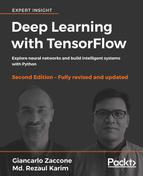In this chapter, we looked at some TensorFlow-based libraries for DL research and development. We introduced tf.estimator, which is a simplified interface for DL/ML, and is now part of TensorFlow and a high-level ML API that makes it easy to train, configure, and evaluate a variety of ML models. We used the estimator feature to implement a classifier for the Iris dataset.
We also had a look at the TFLearn library, which wraps a lot of TensorFlow APIs. In the example, we used TFLearn to estimate the chance of survival of passengers on the Titanic. To tackle this task, we built a DNN classifier.
Then, we introduced PrettyTensor, which allows TensorFlow operations to be wrapped to chain any number of layers. We implemented a convolutional model in the style of LeNet to quickly resolve the handwritten classification model.
Then we had a quick look at Keras, which is designed for minimalism and modularity, allowing the user to quickly define DL models. Using Keras, we have learned how to develop a simple single-layer LSTM model for the IMDB movie review sentiment classification problem. In the last example, we used Keras' functionality to build a SqueezeNet neural network starting from a pretrained inception model.
The next chapter introduces reinforcement learning. We'll explore the basic principles and algorithms of reinforcement learning. We'll also see some examples using TensorFlow and the OpenAI Gym framework, which is a powerful toolkit for developing and comparing reinforcement learning algorithms.
